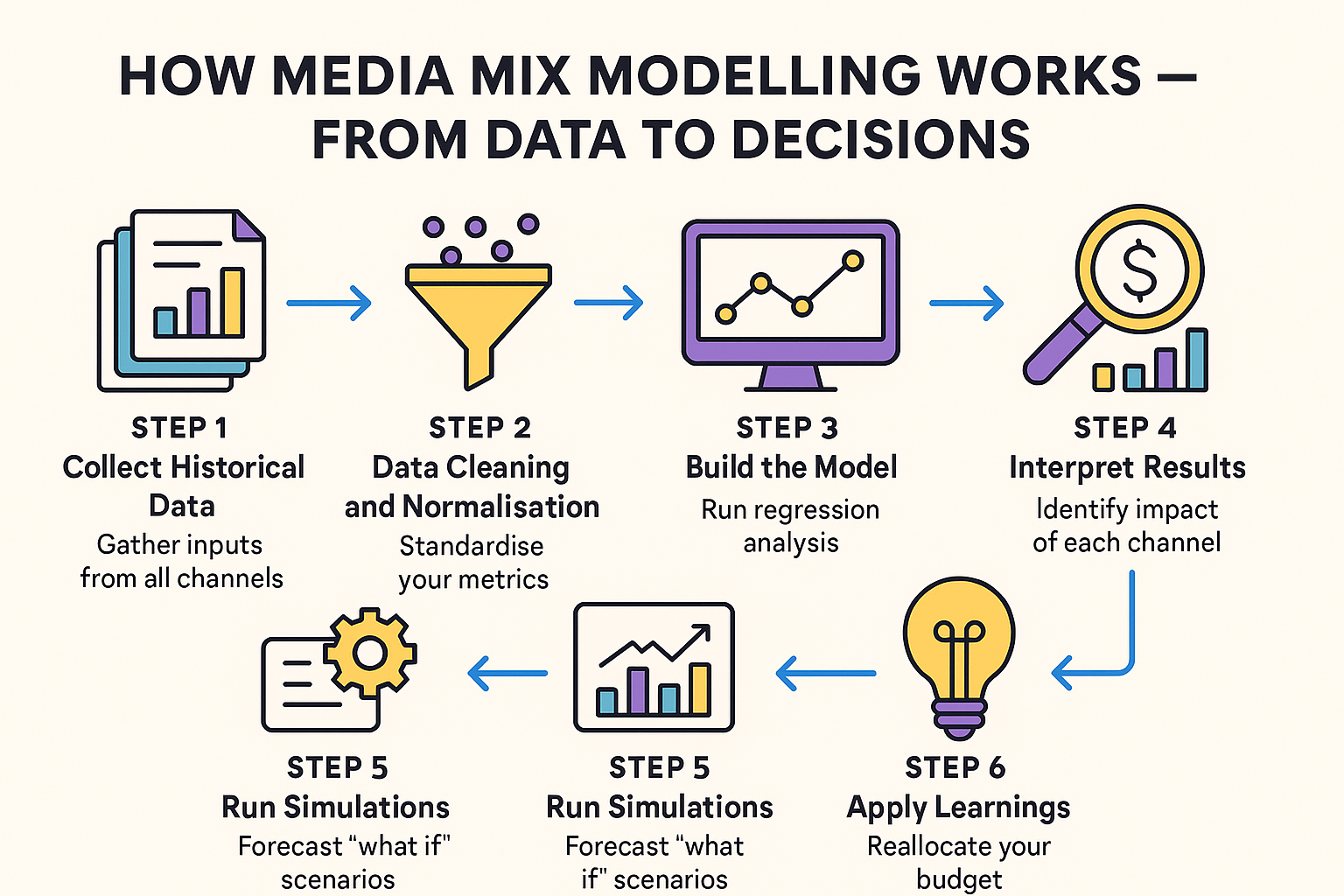In today’s complex digital ecosystem, Australian marketers are juggling dozens of channels — from Google Ads and CTV to TikTok, outdoor, and programmatic.
The challenge? Knowing which channels actually drive results.
Enter Media Mix Modelling (MMM) — a proven, data-driven approach that helps marketers measure the real impact of every channel, online and offline.
Whether you’re a retail brand trying to balance TV and social, or a B2B company evaluating lead sources, MMM provides the insights you need to allocate budgets with confidence — even as third-party cookies disappear. This guide breaks down what MMM is, how it works, why it matters in Australia, and how you can start implementing it today.
What Is Media Mix Modelling (MMM)?
Media Mix Modelling (MMM) is a data-driven statistical technique that measures the contribution of various marketing and external factors to your overall business performance — typically sales, leads, or conversions.
At its core, MMM answers a single but powerful question:
“Which marketing activities are truly driving results — and by how much?”
Unlike short-term attribution models that focus on individual user journeys, MMM takes a holistic, macro-level approach, evaluating all marketing channels (online and offline) together over time.
How MMM Works
MMM relies on historical data — typically two or more years of information — including marketing spend, sales outcomes, and external influences such as seasonality or competitor activity.
This data is fed into regression models, which statistically determine how much each input (like Facebook Ads, TV spend, or discount promotions) contributes to your desired outcomes.
Through this analysis, businesses can:
✅ Quantify ROI per channel — discover exactly how much revenue each marketing dollar generates.
✅ Identify diminishing returns — pinpoint the point where adding more budget stops improving results.
✅ Forecast future outcomes — simulate budget reallocation scenarios to see how different mixes impact sales or leads.
Example:
A national retail chain might use MMM to discover that:
-
Search and YouTube advertising deliver the strongest incremental sales,
-
Radio supports top-of-funnel awareness but reaches saturation after a certain spend, and
-
Seasonal promotions and weather conditions heavily influence regional performance.
With these insights, the marketing team can reallocate spend toward high-performing channels and fine-tune campaign timing to maximise ROI.
Why MMM Is Essential for Australian Marketers
The digital advertising landscape is undergoing a seismic shift.
As third-party cookies disappear and privacy laws like the Privacy Act 1988 and Australian Privacy Principles (APPs) become more stringent, marketers are losing access to granular, user-level data.
Traditional attribution models — such as last-click or multi-touch attribution (MTA) — are becoming less effective. They depend on individual tracking that will soon be obsolete.
Why MMM Is the Solution
Media Mix Modelling provides a future-proof, privacy-safe measurement framework because it:
-
Uses aggregated, anonymised data instead of personal identifiers.
-
Incorporates both digital and offline channels, giving a unified performance view.
-
Enables data-driven decision-making even in a cookie-free environment.
Key Benefits for Australian Businesses
🇦🇺 Privacy-Resilient:
MMM fully aligns with Australian privacy regulations, helping brands remain compliant while maintaining deep insight into marketing performance.
💰 Budget Efficiency:
By focusing on incremental ROI rather than vanity metrics, MMM ensures every marketing dollar is strategically allocated.
📈 Cross-Channel Clarity:
Unlike attribution tools that only track digital interactions, MMM evaluates all touchpoints — from Google Ads and Meta campaigns to TV, print, outdoor, and sponsorships.
🎯 Scenario Forecasting:
Run “what-if” simulations to model how shifting spend between channels (e.g., moving budget from Meta to YouTube) will affect results.
💡 Industry Insight:
According to IAB Australia, more than 60% of major Australian advertisers are investing in MMM solutions to future-proof their measurement strategies in the post-cookie era.

MMM vs Attribution Modelling
While both aim to measure marketing effectiveness, MMM and Attribution Modelling differ in scope, methodology, and purpose.
| Feature | Media Mix Modelling (MMM) | Attribution Modelling (MTA) |
|---|---|---|
| Data Type | Aggregated, historical data (sales, spend, market factors) | User-level, cookie-based data |
| Scope | Macro-level, cross-channel | Micro-level, digital only |
| Time Frame | Long-term (months or years) | Short-term (sessions or campaigns) |
| Privacy Compliance | Fully compliant with GDPR and APPs | Depends on personal data tracking |
| Channels Covered | TV, radio, print, OOH, digital, social, etc. | Primarily digital |
| Primary Use Case | Strategic budgeting and forecasting | Tactical campaign optimisation |
In Summary
-
Attribution Modelling helps you optimise in real-time — useful for campaign-level decisions.
-
Media Mix Modelling helps you plan for the long term — ideal for strategic budgeting and forecasting.
Savvy marketing teams use both: MMM for macro-level strategy, and attribution for micro-level execution.
Key Components of Media Mix Modelling
A successful MMM framework depends on data quality, model design, and cross-functional collaboration between marketing, analytics, and finance teams.
Below are the essential data categories and considerations for building an accurate model.
A. Marketing Data
Collect data across all paid, owned, and earned media channels, including:
-
Media spend per channel: TV, digital, radio, OOH, print, etc.
-
Campaign metrics: impressions, reach, frequency, GRPs (Gross Rating Points).
-
Performance metrics: CPC, CPM, CTR, conversion rate.
-
Owned media: website traffic, social engagement, and CRM/email performance.
B. Business Data
Your MMM model should be anchored to business outcomes, not just marketing KPIs:
-
Sales and revenue data (daily, weekly, or monthly).
-
Leads or customer acquisition data.
-
Pricing strategies, promotions, and product launches.
-
Customer churn or retention rates for subscription-based models.
C. External Factors
To isolate marketing’s true impact, MMM must account for non-marketing influences such as:
-
Seasonality (e.g., holiday peaks, summer slumps).
-
Economic indicators (e.g., inflation, consumer confidence).
-
Competitor actions (new launches, pricing wars).
-
Weather patterns affecting category demand (e.g., beverage sales rise in heatwaves).
-
Cultural or retail events like EOFY, Boxing Day, or Black Friday.
📊 Pro Tip:
The more granular your time series data (e.g., daily vs monthly), the better MMM can detect short-term effects like promotions or external shocks.
Building a Media Mix Modelling Framework
To operationalise MMM, marketers must go beyond theory and embed it into their decision-making process.
Here’s a step-by-step approach to building an MMM framework for your business:
Step 1: Define Your Objectives
Identify what you want to measure — is it sales uplift, brand awareness, or lead generation?
Your goal determines which data inputs and model structures you’ll use.
Step 2: Gather and Clean Data
Collect data from all relevant sources — ad platforms, CRM systems, finance tools, and external datasets.
Ensure it’s consistent, complete, and time-aligned (e.g., weekly intervals).
Step 3: Build the Model
Use advanced analytics tools like:
-
Google Lightweight MMM (LMMM) – Open-source, ideal for experimentation.
-
Meta’s Robyn – Automated MMM solution using Bayesian regression and ridge optimisation.
-
Python or R-based models – Custom-built for enterprise-level complexity.
Step 4: Validate and Interpret Results
Validate your model’s accuracy by comparing predictions to actual results.
Identify which channels deliver incremental impact versus baseline effects (sales that would happen anyway).
Step 5: Apply and Iterate
Use MMM insights to reallocate budgets toward high-performing channels.
Repeat the modelling process every 6–12 months to account for market changes and new campaign data.
The Future of MMM in Australia
Australia’s marketing ecosystem is entering a measurement renaissance — one driven by data ethics, AI, and privacy-first innovation. MMM sits at the centre of this transformation.
Emerging trends include:
-
AI-driven modelling: Machine learning enhances MMM accuracy and speed.
-
Real-time MMM dashboards: Integrating live data streams for ongoing optimisation.
-
Hybrid MMM + MTA models: Combining the best of both worlds for full-funnel clarity.
-
Industry collaboration: As major Australian brands in retail, finance, and travel adopt MMM, shared learnings are accelerating adoption and standardisation.
Conclusion
Media Mix Modelling empowers marketers to make smarter, evidence-based decisions about their media budgets — even in a world without cookies or user-level tracking. It’s not just a measurement tool — it’s a strategic compass for modern marketing.
✅ Optimise cross-channel performance
✅ Predict future outcomes
✅ Build resilience in a privacy-first world
Partner with Undivided Digital Marketing Agency
At Undivided Digital Marketing Agency, we help Australian brands harness the power of Media Mix Modelling to unlock clarity, efficiency, and growth.
Our data experts combine statistical rigour with marketing insight to help you:
-
Build custom MMM frameworks tailored to your business goals
-
Translate complex analytics into actionable strategies
-
Integrate MMM insights into your broader marketing planning process
📞 Ready to make every marketing dollar count?



.png?width=180&height=51&name=image%202%20(2).png)